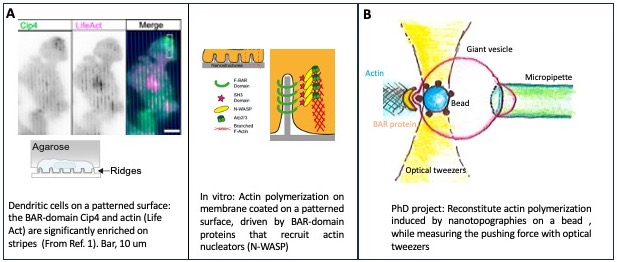Recent studies have shown that cells are able to sense small topographical features and to respond to them by locally assembling different types of actin-based structures (actin-patches, podosomes) on these textures. These structures influence the motility of the cells, adhering or not to the surface (Fig.1A, Left), and the localization of podosomes in macrophages. Cell biology experiments show that curvature-sensitive proteins from the BAR-family are recruited at the position of the topographic features12 [1, 2] but why it eventually influences cell motility or the assembly of podosomes (R. Poincloux, private communication) is still unclear.
The objective of the master internship will be to test in vitro that the BAR-domain proteins, identified in cells by our biologist colleagues as being recruited on nanotographic features, (i) are effectively sensing the membrane deformations induced by the substrate, and (ii) responsible for the assembly of actin structures. The project will be developed in collaboration with biologists: Michael Sixt (IST Austria) expert of motility in non-adhering cells, Renaud Poincloux (IPBS, Toulouse) expert of podosomes. Purified proteins and model membrane systems supported by the microfabricated substrate will be used (Fig.1A, Right). Microfabrication will be done together with M. Sixt, and Laurent Malaquin (LAAS, Toulouse). With fluorescence microscopy (TIRF and confocal microscopy), we will quantify the local enrichment of the BAR-proteins on the nanostructures3 [3].
This project is part of a larger project funded by the ERC (PushingCell), where we aim at understanding how non-adhering cells use the topography of their environment for moving by pushing on it. The internship can be continued with a PhD where we will determine how surface topography and thus membrane curvature-driven actin polymerization exerts pushing or pulling forces on the membrane and deforms it, using reconstituted systems (Fig.1B). We will also measure the corresponding forces with optical tweezers. The results will be discussed with our collaborators of the ERC project: Pierre Sens and his students, theoreticians in the Physico-Chimie Curie lab, as well as with biologists, Michael Sixt (IST Austria) and Anna Akhmanova (Uni. Utrecht).
